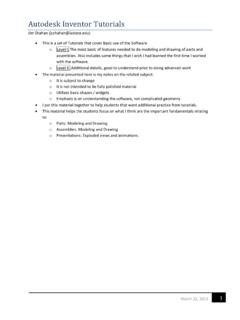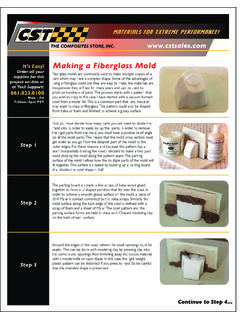Transcription of MT-101: Decoupling Techniques - Analog Devices
1 MT-101. TUTORIAL. Decoupling Techniques WHAT IS PROPER Decoupling AND WHY IS IT NECESSARY? Most ICs suffer performance degradation of some type if there is ripple and/or noise on the power supply pins. A digital IC will incur a reduction in its noise margin and a possible increase in clock jitter. For high performance digital ICs, such as microprocessors and FPGAs, the specified tolerance on the supply ( 5%, for example) includes the sum of the dc error, ripple, and noise. The digital device will meet specifications if this voltage remains within the tolerance. The traditional way to specify the sensitivity of an Analog IC to power supply variations is the power supply rejection ratio (PSRR). For an amplifier, PSRR is the ratio of the change in output voltage to the change in power supply voltage, expressed as a ratio (PSRR) or in dB (PSR). PSRR can be referred to the output (RTO) or referred to the input (RTI).
2 The RTI value is equal to the RTO value divided by the gain of the amplifier. Figure 1 shows how the PSR of a typical high performance amplifier (AD8099) degrades with frequency at approximately 6 dB/octave (20 dB/decade). Curves are shown for both the positive and negative supply. Although 90 dB at dc, the PSR drops rapidly at higher frequencies where more and more unwanted energy on the power line will couple to the output directly. Therefore, it is necessary to keep this high frequency energy from entering the chip in the first place. This is generally done with a combination of electrolytic capacitors (for low frequency Decoupling ), ceramic capacitors (for high frequency Decoupling ), and possibly ferrite beads. Power supply rejection of data converters and other Analog and mixed-signal circuits may or may not be specified on the data sheet. However, it is very common to show recommended power supply Decoupling circuits in the applications section of the data sheet for practically all linear and mixed-signal ICs.
3 These recommendations should always be followed in order to ensure proper operation of the device. Figure 1: Power Supply Rejection vs. Frequency for the AD8099 High Performance Op Amp , 03/09, WK Page 1 of 14. MT-101. Low frequency noise requires larger electrolytic capacitors which act as charge reservoirs to transient currents. High frequency power supply noise is best reduced with low inductance surface mount ceramic capacitors connected directly to the power supply pins of the IC. All Decoupling capacitors must connect directly to a low impedance ground plane in order to be effective. Short traces or vias are required for this connection to minimize additional series inductance. Ferrite beads (nonconductive ceramics manufactured from the oxides of nickel, zinc, manganese, or other compounds) are also useful for Decoupling in power supply filters. At low frequencies (<100 kHz), ferrites are inductive; thus they are useful in low-pass LC filters.
4 Above 100 kHz, ferrites becomes resistive (high Q). Ferrite impedance is a function of material, operating frequency range, dc bias current, number of turns, size, shape, and temperature. The ferrite beads may not always be necessary, but they will add extra high frequency noise isolation and Decoupling , which is often desirable. Possible caveats here would be to verify that the beads never saturate, especially when op amps are driving high output currents. When a ferrite saturates it becomes nonlinear and loses its filtering properties. Note that some ferrites, even before full saturation occurs, can be nonlinear. Therefore, if a power stage is required to operate with a low distortion output, the ferrite should be checked in a prototype if it is operating near this saturation region. The key aspects of proper Decoupling are summarized in Figure 2. A large electrolytic capacitor (typically 10 F 100 F) no more than 2 in.
5 Away from the chip. z The purpose of this capacitor is to be a reservoir of charge to supply the instantaneous charge requirements of the circuits locally so the charge need not come through the inductance of the power trace. A smaller cap (typ. F F) as physically close to the power pins of the chip as is possible. z The purpose of this capacitor is to short the high frequency noise away from the chip. All Decoupling capacitors should connect to a large area low impedance ground plane through a via or short trace to minimize inductance. Optionally a small ferrite bead in series with the supply pin. z Localizes the noise in the system. z Keeps external high frequency noise from the IC. z Keeps internally generated noise from propagating to the rest of the system. Figure 2: What Is Proper Decoupling ? Page 2 of 14. MT-101. REAL CAPACITORS AND THEIR PARASITICS. Figure 3 shows a model of a non-ideal capacitor.
6 The nominal capacitance, C, is shunted by a resistance, RP, which represents insulation resistance or leakage. A second resistance, RS. (equivalent series resistance, or ESR), appears in series with the capacitor and represents the resistance of the capacitor leads and plates. RP. RS L. C. ESR ESL. RDA CDA. Figure 3: A Real Capacitor Equivalent Circuit Includes Parasitic Elements Inductance, L (the equivalent series inductance, or ESL), models the inductance of the leads and plates. Finally, resistance RDA and capacitance CDA together form a simplified model of a phenomenon known as dielectric absorption, or DA. When a capacitor is used in a precision application, such as a sample-and-hold amplifier (SHA), DA can cause errors. In a Decoupling application, however, the DA of a capacitor is generally not important. Figure 4 shows the frequency response of various 100 F capacitors.
7 Theory tells us that the impedance of a capacitor will decrease monotonically as frequency is increased. In actual practice, the ESR causes the impedance plot to flatten out. As we continue up in frequency, the impedance will start to rise due to the ESL of the capacitor. The location and width of the "knee". will vary with capacitor construction, dielectric and value. This is why we often see larger value capacitors paralleled with smaller values. The smaller value capacitor will typically have lower ESL and continue to look like a capacitor higher in frequency. This extends the overall performance of the parallel combination over a wider frequency range. Page 3 of 14. MT-101. 100. Aluminum Switching Type, 10V. Low ESR Tantalum, 10V. 10 Polymer Tantalum, 4V. SP-Cap (SL Series), 2V. Ceramic, ESL = 16nH. 1. Z . ESL = 100 m 10 m 1m 100 1k 10k 100k 1M 10M. FREQUENCY (Hz) ESR = 0.
8 1 1. Self-Resonant Frequency =. 2 ESL C. Figure 4: Impedance of Various 100 F Capacitors The self-resonant frequency of the capacitor is the frequency at which the reactance of the capacitor (1/ C), is equal to the reactance of the ESL ( ESL). Solving this equality for the resonant frequency yields: 1. f RESONANCE = . Eq. 1. 2 ESL C. All capacitors will display impedance curves which are similar in general shape to those shown. The exact plots will be different, but the general shape stays the same. The minimum impedance is determined by the ESR, and the high frequency region is determined by the ESL (which in turn is strongly affected by package style). TYPES OF Decoupling CAPACITORS. Figure 5 shows the various types of popular capacitors suitable for Decoupling . The electrolytic family provides an excellent, cost effective low-frequency filter component because of the wide range of values, a high capacitance-to-volume ratio, and a broad range of working voltages.
9 It includes general-purpose aluminum electrolytic switching types, available in working voltages from below 10 V up to about 500 V, and in size from 1 F to several thousand F (with proportional case sizes). Page 4 of 14. MT-101. TECHNOLOGY ADVANTAGES DISADVANTAGES APPLICATIONS. Aluminum Electrolytic, High CV Temperature related Consumer products Switching Type. product/cost wearout Large bulk storage Avoid general purpose Large energy storage High ESR/size types Best for 100V - 400V High ESR @ low temp Solid Tantalum High CV product/size Fire hazard with reverse Popular in military Stable @ cold temp voltage Concern for tantalum No wearout Expensive raw material supply Only rated up to 50V. Aluminum-Polymer, Low ESR Rapid degradation Newest technology Special-Polymer, Z stable over temp above 105 C CPU core regulators Poscap, Os-Con Relatively small case Relatively high cost Ceramic Lowest ESR, ESL CV product limited Excellent for HF.
10 High ripple current Microphonics Decoupling X7R good over wide C decreases with Good to 1 GHz temp increasing voltage Film (Polyester, Teflon, Hi Q in large sizes CV product limited High voltage, current polypropylene, No wearout Not popular in SMT AC. polystyrene, etc. High voltage High cost Audio Figure 5: Popular Capacitor Types All electrolytic capacitors are polarized, and thus cannot withstand more than a volt or so of reverse bias without damage. They have relatively high leakage currents (this can be tens of A). which is strongly dependent upon specific family design, electrical size, and voltage rating versus applied voltage. However, leakage current is not likely to be a major factor for basic Decoupling applications. "General purpose" aluminum electrolytic capacitors are not recommended for most Decoupling applications. However, a subset of aluminum electrolytic capacitors is the "switching type,".)

















